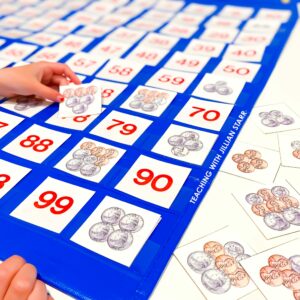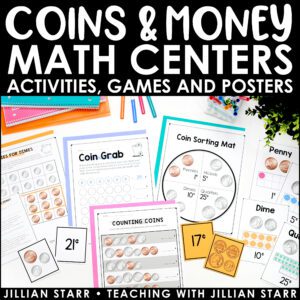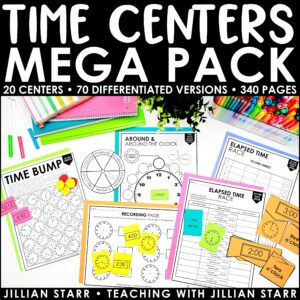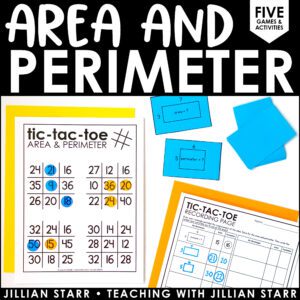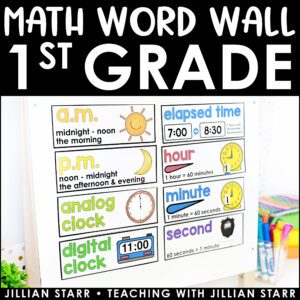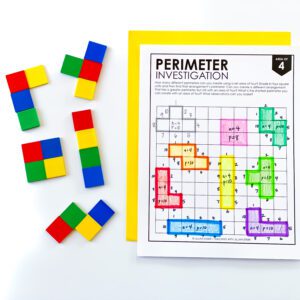
In the math world, measurement skills are among the most universally applicable. From the length of a ribbon to the height of a growing sunflower, even the distance between two picture frames, measurement surrounds us in our daily lives. For students, understanding and mastering concepts like length, width, height, and beyond not only empowers them but also lays the foundation for future math and science skills and even multiple career paths.
In this post, we’re diving into why you might want to spend more time on length, width, and height, how to incorporate estimation, and how to do all of this work while providing students with hands-on, engaging activities that spark curiosity and deepen students’ understanding of measurement.
Measuring Length, Width, & Height
Let’s start by talking about why it’s worth spending more time teaching the measurement of length, width, and height. I have used several math programs over the years and almost all of them left measurement to the end of the school year. With packed schedules, end-of-year field trips, assemblies, and building summer excitement, measurement often gets glossed over quickly. Relatable, right?
Compare that to how often you actually need to measure the length, width, or height of an object in daily life. How many times have you read the dimensions of an object while online shopping? Measured a room to find a rug that fits? Measured the length of a wall to find the center to hang artwork…I could go on and on!
I’m sure you can think of dozens of your own examples where you needed to measure the length, width, and height of objects. Unfortunately, in the classroom, measurement often gets shortchanged and the focus becomes measurement conversions in isolation and without the purposeful, real-life connection. Meanwhile, students can get a lot from digging deep into meaningful, practical math: engagement, real-life skills, curiosity, and confidence, which is why including this kind of deep work in your math instruction can create a powerful change!
Estimating Length, Width & Height
Estimating is determining the value of something using incomplete or uncertain information. Although the calculation will not be exact, it can still be very useful. Let’s revisit our earlier example of hanging artwork. Did I actually measure the length and height of the wall, or did I eyeball it? Sometimes we don’t need to know things exactly. This is where estimation enters real life. And in fact, estimation is a highly valuable tool for making sense of the world.
Students can use estimation as well. In fact, estimation is often a concept that students misunderstand. For instance, when asked to estimate the sum of 19 + 43, I have seen countless students first calculate the sum exactly getting 62, and then estimate the sum to be 60 when they already have an exact answer. What those students didn’t understand is that estimation is used to get a calculation that is close enough for a given situation.
Incorporating estimation can be done by including activities like an estimation jar and estimating lengths and distances within the school day. The estimation jar is a classic! All you have to do is put a bunch of the same item into a clear jar or container. Then students use what they know and can see to estimate how many objects are in the container. Leave the estimation jar out for a few days to give students time to observe and even revise their estimates. As usual, one of the most important parts of this activity is the discussion afterward.
Want to take this activity to the next level? Don’t just reveal the actual amount, make it dramatic! We’ve had some seriously engaging discussions about how students made their estimates and what they might do differently when estimating next time. This discussion helps students to build their estimation skills. While they are not necessarily estimating length, width, or height here, the estimation strategies developed here definitely transfer.
Another great way to incorporate estimation is by estimating lengths, widths, and heights as they naturally come up in the process of a school day. For example, we sometimes have very short transition times between a special and recess. This is a great real-life scenario to work in estimation! I’ll ask students to estimate the distance from the classroom to the recess door and we’ll even talk about how long they think it will take us to cover that distance.
Both of these examples are ways I include estimation of length, width, and height into daily classroom activities. This estimation can be a longer activity or it can be a brief discussion – whatever you have time for!
Of course, there are also ways to tie estimation into regular measurement lessons. When introducing units of measure for length, width, and height, I always ask students to estimate how big those units are before introducing their actual size.
For instance, when introducing the inch, I’ll ask students to show me how big they think an inch is. Most students will use their fingers to show their estimation of the size of an inch but others who are less familiar may show it differently. From there, I will show students a paper clip, share that it is an inch long, and ask them to show me how big that is with their fingers. Finally, we’ll investigate the actual length of an inch using rulers.
I repeat these activities when introducing other units of measurement, including when we are working with metric units. These activities give students a visual connection to the actual size of a given unit which supports their ability to estimate the length, width, or height of objects.
Sometimes an estimate is not enough and precise measurements are, in fact, necessary. In these cases, the need for precision rather than estimations is a topic to discuss with students. One of my favorite activities is to provide students with various scenarios such as the ones I described earlier and ask students to decide if they would need a precise measurement of length, width, or height or if an estimate would suffice. This activity has led to a lot of fun, engaging math debates!
Hands-on Experiences for Length, Width & Height
You know I always love to include a game when teaching math and measurement is no different. Not only do I want students to be able to measure an object (I’ll talk more about that one in a minute!), but I also want students to be able to use measurement to create. Being able to draw lines with specific lengths plays a role in art, architecture, and even something as simple as hanging a picture frame.
This is where the game Measurement Tag comes in. This game gives students the opportunity to practice drawing lines of specific lengths in a fun way. Students roll dice to determine how long of a line they draw. The “tagger” is trying to catch the other player at their latest stopping point. Students love this game and it’s a fun way to practice using a ruler to draw lines.
Of course, nothing beats giving students purposeful hands-on experiences with measuring, like measuring the length of the classroom countertop or the height of the school door. Sometimes in the rush of a lesson, teachers will demonstrate how to measure objects but not provide the opportunity for students to hold the tool themselves. No judgment – I’ve been there too!
When assigning measurement tasks, I have students decide the appropriate tool to use. Suppose I am asking students to measure the width of their notebooks. I will provide them with a variety of tools: rulers, yardsticks, measuring tapes, cubes, etc. Students then need to decide what tool will work best, use it, and then justify their choice.
The tool that students select when measuring their notebooks will likely be different than what they select when measuring the height of the door. However, it is always a wonderful discussion when students do select tools that are less efficient. While using a 6-inch ruler can help us to accurately measure the height of the door, it is much less efficient than using a measuring tape! Learning that through a hands-on activity and actually experiencing the struggle of using a tiny ruler is much more powerful than just being told it will be harder.
And at the end of the day…that’s what we want! We want students to have meaningful, memorable, hands-on experiences to deepen their understanding of measuring length, width, and height. The best part is that these skills will be useful well beyond their school days.
I know there are lots of other wonderful ways to support students measuring with purpose. If you have other favorite activities, comment below or shoot me an email. I love hearing from all of you wise educators!

